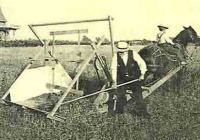








A reaper is a farming tool or person that reaps (cuts and gathers) crops at harvest, when they are ripe.
Early history
It is believed that either Romans or the Celts before them, invented a simple mechanical reaper that cut the ears without the straw and was pushed by oxen (Pliny the Elder Naturalis Historia XVIII,296). This device was forgotten in the Dark Ages, during which period reapers reverted to using scythes and sickles to gather crops.
Thomas Dobbs (actor) of Birmingham invents a reaping machine in 1814, which consists of a circular saw or sickle, the grain is drawn or fed up to the saw by means of a pair of rollers.
Patrick Bell of Scotland created a reaper that used a revolving reel, cutting knife and canvas conveyor in 1828. This machine was used around his county and some may have been exported, but the device was never patented. One of Bell's reaping machines is preserved in the National Museum of Rural Life in Scotland.
Mechanical reapers in the U.S.
The 19th century saw several inventors in the United States claim innovation in mechanical reapers.The various designs competed with each other, and were the subject of several lawsuits.
Obed Hussey in Ohio patented a reaper in 1833, the Hussey Reaper.Made in Baltimore, Maryland, Hussey's design was a major improvement in reaping efficiency. The new reaper only required two horses working in a non-strenuous manner, a man to work the machine, and another person to drive. In addition, the Hussey Reaper left an even and clean surface after its use.
The McCormick Reaper was designed by Robert McCormick in Walnut Grove, Virginia. However, Robert became frustrated when he was unable to perfect his new device. His son Cyrus asked for permission to try to complete his father's project. With permission granted,the McCormick Reaper was patented by his son Cyrus McCormick in 1837 as a horse-drawn farm implement to cut small grain crops.This McCormick reaper machine had several special elements:
a main wheel frame
projected to the side a platform containing a cutter bar having fingers through which reciprocated a knife driven by a crank
upon the outer end of the platform was a divider projecting ahead of the platform to separate the grain to be cut from that to be left standing
a reel was positioned above the platform to hold the grain against the reciprocating knife to throw it back upon the platform
the machine was drawn by a team walking at the side of the grain.
Cyrus McCormick claimed that his reaper was actually invented in 1831, giving him the true claim to the general design of the machine. Over the next few decades the Hussey and McCormick reapers would compete with each other in the marketplace, despite being quite similar.
In 1861, the United States Patent and Trademark Office issued a ruling on the invention of the polarizing reaper design. It was determined that the money made from reapers was in large part due to Obed Hussey. S.T. Shugert, the acting commissioner of patents, declared that Hussey's improvements were the foundation of their success. It was ruled that the heirs of Obed Hussey would be monetarily compensated for his hard work and innovation by those who had made money off of the reaper. It was also ruled that McCormick's reaper patent would be renewed for another 7 years.
Although the McCormick reaper was a revolutionary innovation for the harvesting of crops, it did not experience mainstream success and acceptance until at least 20 years after it was patented by Cyrus McCormick. This was because the McCormick reaper lacked a quality unique to Obed Hussey's reaper. Hussey's reaper used a sawlike cutter bar that cut stalks far more effectively than McCormick's. Only once Cyrus McCormick was able to acquire the rights to Hussey's cutter-bar mechanism (around 1850) did a truly revolutionary machine emerge.Other factors in the gradual uptake of mechanized reaping included natural cultural conservatism among farmers (proven tradition versus new and unknown machinery); the poor state in which many new farm fields were in, including rocks, stumps, and uneven soil, which made the lifespan and operability of a reaping machine questionable; and some amount of fearful Luddism among farmers that the machine would take away jobs, most especially among hired manual labourers.
Reapers in the late 19th and 20th century
After the first reapers were developed and patented, other slightly different reapers were distributed by several manufacturers throughout the world. The Champion (Combined) Reapers and Mowers, produced by the Champion Interest group (Champion Machine Company, later Warder, Bushnell & Glessner, absorbed in IHC 1902) in Springfield, Ohio in the second half of the 19th century, were highly successful in the 1880s in the United States.Springfield is still known as "The Champion City".
Generally, reapers developed into the 1872 invented reaper-binder, which reaped the crop and bound it into sheaves. By 1896, 400,000 reaper-binders were estimated to be harvesting grain and bananas.This was in turn replaced by the swather and eventually the combine harvester, which reaps and threshes in one operation.
In Central European agriculture reapers were – together with reaper-binders – common machines until the mid-20th century.